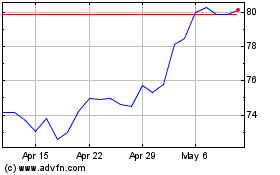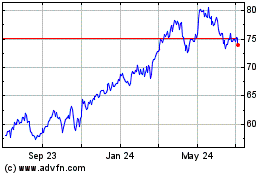NEW YORK—Four living Federal Reserve leaders—including current
Chairwoman Janet Yellen—sought to dispel worries the U.S. is
heading back toward recession despite concerns about slow global
growth and the expansion's advancing age.
Ms. Yellen, joined Thursday in an unusual gathering in New York
by former Fed Chairmen Ben Bernanke, Alan Greenspan and Paul
Volcker, described an economy that is progressing without breeding
obvious new financial bubbles that could derail growth.
"This is an economy on a solid course, not a bubble economy,"
Ms. Yellen said. It has made "tremendous progress" from the damage
of the 2007-2009 financial crisis.
"The domestic U.S. economy is moving forward," Mr. Bernanke
added. "I don't see any particular reason to believe a recession is
any more likely in 2016 than it was in 2015 or 2014." Though the
U.S. expansion is already older than the average post World War II
expansion, he said expansions don't die of old age. Instead, they
reverse when imbalances throw off spending and investment. Messrs.
Greenspan and Volcker largely concurred.
"I doubt very much if a recession is what our problem is," Mr.
Greenspan said. He said policy makers needed to be focused on slow
productivity growth which is holding the economy's growth rate
down.
Taken altogether, their comments marked a sign of guarded
confidence from a quartet of the world's most powerful economic
policy makers, past and present, at a moment with political
undertones. Republican presidential front-runner Donald Trump has
argued the U.S. is a bubble economy heading toward severe
recession. The Fed's own critics have argued its low interest rate
policies and repeated bond-purchase programs have inflated
financial asset prices and made them prone to decline.
The gathering was held at the International House in New York.
Ms. Yellen was joined on stage by Messrs. Bernanke and Volcker, and
Mr. Greenspan joined by video connection. It was the first time all
four had spoken together at such great length in public and comes
at a moment with a central bank in flux and facing intense public
scrutiny. In that respect, the gathering was a chance for the
leadership of the institution during the past 37 years to defend
it.
The Fed took extraordinary measures during and after the
2007-2009 financial crisis, including bailouts of banks and the
giant insurer American International Group Inc., along with
bond-purchase programs that have swelled its portfolio of assets.
Lawmakers have demanded more openness on the part of the central
bank and questioned the bank bailouts, putting it in a long-running
battle to restore public trust in its conduct and role in the
economy.
"Many people are unhappy with the economy," Mr. Bernanke said.
"All the Fed can do is try to do the right thing."
The current Fed leader was at times pressed to defend herself.
The Fed raised its benchmark interest rate in December after
keeping it near zero for seven years to boost borrowing, spending
and investment. In the face of headwinds to global growth and
financial market turbulence, the Fed has since scaled back its
plans for rate increases this year.
"I don't think December was a mistake," Ms. Yellen said. "We
remain on a reasonable path."
Financial bubbles are often marked by large increases in private
sector debt and overvalued asset prices. "We certainly don't see
those imbalances," she said.
Ms. Yellen spoke a day after the Fed released minutes of the
central bank's March policy meeting. At that meeting, officials
left their short-term interest rate target range unchanged at 0.25%
to 0.50% as policy makers waited to see how slowing global economic
growth and financial market volatility was affecting the U.S.
economy.
Most economists surveyed by The Wall Street Journal in recent
days expect the next Fed rate increase in June.
The minutes indicated most officials didn't expect to raise
rates at their meeting later this month. Ms. Yellen didn't tip her
hand about the outlook in her public comments, saying "we think a
gradual path of rate increases will be appropriate and stand ready
to adjust what we do based on how our views of the economy
evolve."
The Fed leader said the economy has shown a lot of improvement
in hiring, with the current jobless rate of 5% close to the full
employment, which suggests the further that measure goes down, the
more likely inflation pressures are to build. Ms. Yellen said weak
inflation is due to transitory factors that are likely to subside,
and she said she expect price pressures to continue to tick
higher.
She also noted that while the strength of the dollar has been a
drag on the economy, the Fed doesn't use its policy tools to
achieve a particular exchange rate.
Ms. Yellen also said the process of boosting borrowing costs had
so far gone smoothly and showed the central bank has the
appropriate tools to control short-term rates.
She said the Fed would at some point take steps to shrink its
$4.5 trillion balance sheet, but she didn't say when that would
happen.
Ms. Yellen was asked about recent comments by the new president
of the Minneapolis Fed, Neel Kashkari, who has made waves by
launching an effort to address the issue of whether some financial
firms are so large the government would have to rescue them to
prevent their collapse from wrecking the financial system—a worry
called too-big-too-fail. He has said the nation's largest banks may
need breaking up to strengthen the financial system.
Ms. Yellen countered that she believes current reform efforts
have made progress on the problem and that she didn't share Mr.
Kashkari's pessimism about the situation.
But she, unlike some critics, had no problem with Mr. Kashkari
raising the issue. Ms. Yellen cited the decentralized nature of the
Fed and said a "diversity of opinions is a positive attribute" for
the Fed, adding "it's within his purview to look at these
issues."
Write to Michael S. Derby at michael.derby@wsj.com
(END) Dow Jones Newswires
April 07, 2016 21:05 ET (01:05 GMT)
Copyright (c) 2016 Dow Jones & Company, Inc.
American (NYSE:AIG)
Historical Stock Chart
From Mar 2024 to Apr 2024

American (NYSE:AIG)
Historical Stock Chart
From Apr 2023 to Apr 2024
